#François Duvalier
Explore tagged Tumblr posts
Text
Matthew Isbell at MCI Maps:
This is a unique newsletter issue today. Rather than coverage of an election, its more of a long-delayed commentary on the state of the modern right-wing. The horrible events in Springfield, Ohio have made it so that I just had to put these thoughts down in writing. Specifically, this is coming from my personal perspective as a devout Christian. As I see it, if there was any doubt before, the Trump/Vance weaponizing of Springfield shows just how un-Christian the GOP ticket is. My disdain for Donald Trump and the MAGA movement is no secret. I let it be known in my articles, and if you think that stuff is over the top, you should see my twitter account. I am fairly unique in the left, though hardly alone, in that my dislike for Donald and his followers is driven heavily by religion. While I can sit down and make all the arguments for why I believe left-wing economics is more in line with Christian calls to charity, and why extreme anti-LGBT attacks (calling people groomers and such) are a direct rejection of Christ’s words and actions toward love, this is not the topic of this piece. Unlike the countless far-right twitter users that put a cross in their name and call themselves “Orthodox” or “Trad Cath” and then quote one bible line out of context to justify their shitty behavior, I do not presume to be an expert on parsing all of scripture.
BUT, when looking at the racism and bigotry that permeates the MAGA movement and Trump world, there is plenty that even a novice on Christian doctrine can look at and say “oh this is not acceptable at all.” The attacks on Haitian migrants in Springfield Ohio is a perfect low bar for anyone to condemn. The verbal assault on an entire community, based off debunked neo-Nazi propaganda and repeated by Donald Trump, has, to me, perfectly separated the real from fake Christians. It has separated people who claim the cross from those who actually critically and spiritually engage with the Bible and its message. While I have ranted on twitter PLENTTYYYY about how immoral and Godless I find Donald Trump and his rabid followers, this latest bit of horror has made it so that I need to put this all down in writing - less I explode from bent up rage.
American views of Haiti
Having grown up in southern Broward County, I was exposed to Haitian culture through an increasing migrant population from the island. In fact, back in 2021, I wrote about the arrival of Cuban and Caribbean refugees over South Florida’s last several decades. Give that link a click for more data/maps on the story of South Florida. That article delves into how the US treated Cuban exiles, fleeing communist, differently from Haitian refugees, fleeing dictatorships and instability. Both Cuban and Haitian populations in Miami-Dade suffered backlashes at different times, which I covered there. Haiti is often viewed with a exaggerated caricature; with Voodoo being seen as a common practice in the Island. This was aided by folks like Dictator François Duvalier, also known as Papa Doc, who promoted himself as a Voodoo leader. Growing up in South Florida, EVERYONE knew about Papa Doc, the Voodoo Tyrant. An excellent series by the “Real Dictators” podcast on Papa Doc can be seen here. However, like much of local traditions, the role of Voodoo is often greatly overstated; sometimes by outsiders but also at times Haitian migrants who will lean into the “witch doctor” role to the American and Europeans who love to be wowed by the “primitive superstitions” and drop some cash for a fortune telling. When most Americans think of Haitian culture, they likely have a view similar to the Dr. Facilier song from Princess and the Frog.
[...]
What is Really Happening in Springfield, Ohio
Lets lay out what is actually going on in Springfield, OH. There is no shortage of false stories and fake statistics being thrown out. First, 20,000 Haitian migrants did not show up in the city of Springfield over night. Haitian migrants, many who were already living in South Florida and have visas or protection status, began to move to the city as it worked to attract new residents. Like much of the Midwest, Springfield was becoming a rust-belt town, seeing its population go from 80,000 to 60,000 over the last few decades. It was the site of abandoned buildings, crumbling infrastructure, and declining quality of life. Population drops are never good for the long-term health of a community, this is a constant across history throughout the world. The city successfully attracted new businesses to the community, but was facing a workforce shortage. Simply put, there were not enough workers who needed jobs in the area due to a population drop that had already taken place. Migrants, who by their status have less tying them down to where they are, began to move to the area and filled these jobs.
With the growth, which especially increased after the worst of COVID, there were challenges. Estimated Haitian migrants to the town are between 12,000 and 20,000; and of course the 20,000 is being quoted. The increase, which is high in such a short time, has led to issues with infrastructure and services. However, these issues have not been fatal, and also have been countered by renewed economic growth. In 2022, the local press were referring the growth as a “resurgence” for the area. City leaders are happy with the population increases and the economic renewal that they have inspired. Keep in mind that as people move to an area and work, they build up wealth and re-invest that in the local economy.
The far-right has acted as if immigration dropped off 20,000 migrants with no jobs and destroyed the town. That is a bold faced lie. Claims of increased crime have also been rejected by the law enforcement of the city itself. The data from the city’s court system show no major jump in crime and no evidence of disproportionate crime done by the Haitian residents. Like is commonly the case, immigrants tend to be more well-behaved than native citizens. The rapid growth does lead to challenges, and the city has been working with the state on getting extra funds to provide what they need to. A need for more housing, better roads, and more service centers, is a real issue. However, it is a fixable issue and still beneficial long-term.
[...] A majority of the Haitian migrants are Catholic; which has long roots in Haiti. As such, many churches, whether Catholic or Protestant, have commented on the increased Haitian population leading to increases in church attendance for the first time in decades. Far-right commentators latch onto the history of Voodoo being incorporated into Catholic teachings. However, this of course becomes a racist caricature which overlooks how much modern Haitian Catholicism still mirrors the broad church. Books have also been written extensively on the merging of old “pagan” beliefs with Christianity; whether in South America, North America, or Europe. Always remember the Christmas holiday stems from pagan winter festivals.
Matthew Isbell has a must-read MCI Maps piece on the MAGA lies about Haitian migrants in Springfield, OH are un-Christian.
#Matthew Isbell#J.D. Vance#Donald Trump#Haitians#Christianity#MAGA Cult#Springfield Cat Eating Hoax#François Duvalier#Springfield Ohio#Religion#MCI Maps
6 notes
·
View notes
Text
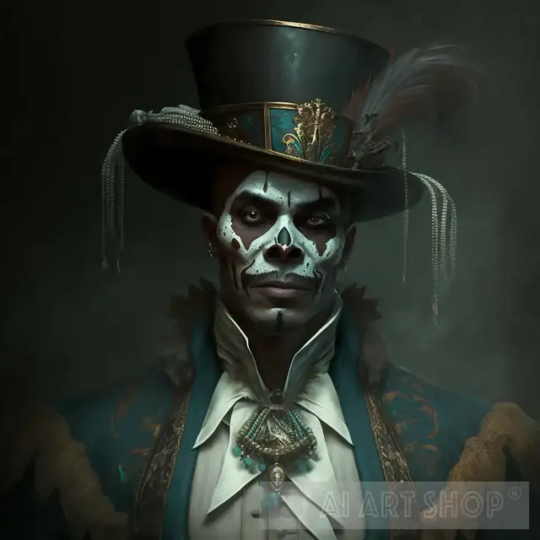
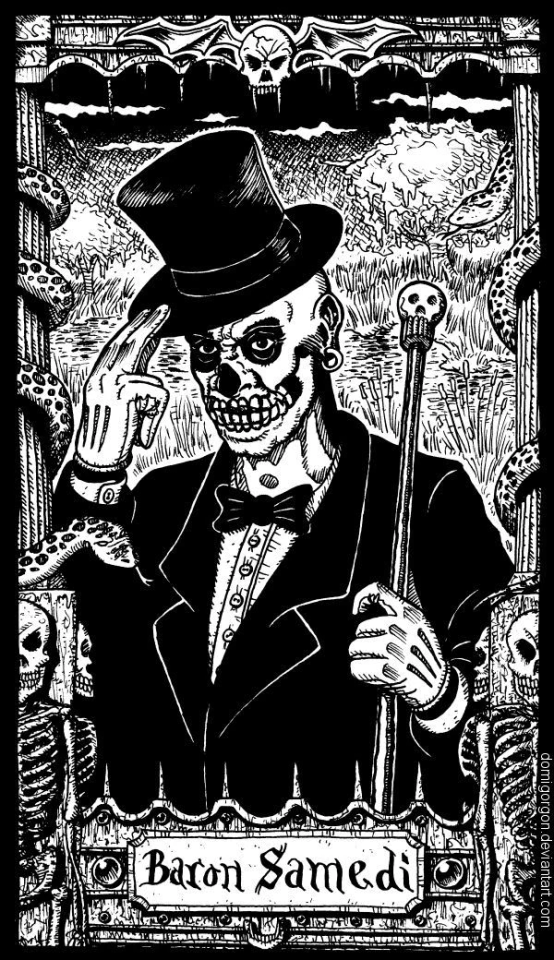

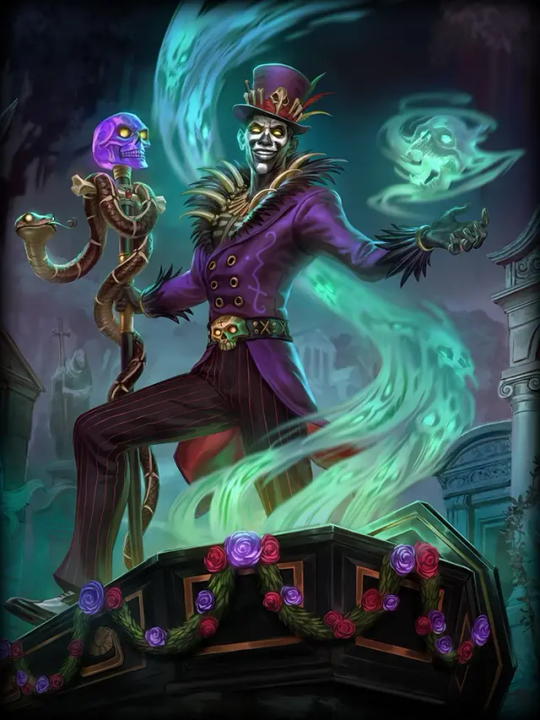
Baron Samedi (English: Baron Saturday), also written Baron Samdi, Bawon Samedi or Bawon Sanmdi, is one of the lwa of Haitian Vodou. He is a lwa of the dead, along with Baron's numerous other incarnations Baron Cimetière, Baron La Croix and Baron Criminel.
He is the head of the Gede family of lwa; his brothers are Azagon Lacroix and Baron Piquant and he is the husband of Maman Brigitte. Together, they are the guardians of the past, of history, and of heritage
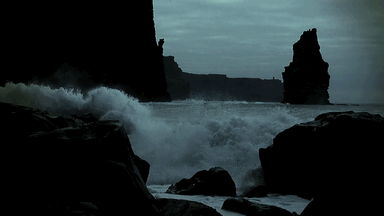
Baron Samedi is usually depicted with a top hat, black tail coat, dark glasses, and cotton plugs in the nostrils, as if to resemble a corpse dressed and prepared for burial in the Haitian style. He is frequently depicted as a skeleton (but sometimes as a black man that merely has his face painted as a skull), and speaks in a nasal voice. The former President-for-Life of Haiti, François Duvalier, known as Papa Doc, modeled his cult of personality on Baron Samedi; he was often seen speaking in a deep nasal tone and wearing dark glasses.
He is noted for disruption, obscenity, debauchery, and having a particular fondness for tobacco and rum. Additionally, he is the lwa of resurrection, and in the latter capacity he is often called upon for healing by those near or approaching death, as it is only the Baron that can accept an individual into the realm of the dead.
Due to affiliation with François Duvalier, Baron Samedi is linked to secret societies in the Haitian government and includes them in his domain.
Baron Samedi spends most of his time in the invisible realm of vodou spirits. He is notorious for his outrageous behavior, swearing continuously and making filthy jokes to the other spirits. He is married to another powerful spirit known as Maman Brigitte, but often chases after mortal women. He loves smoking and drinking and is rarely seen without a cigar in his mouth or a glass of rum in his bony fingers. Baron Samedi can usually be found at the crossroads between the worlds of death and the living. When someone dies, he digs their grave and greets their soul after they have been buried, leading them to the underworld.
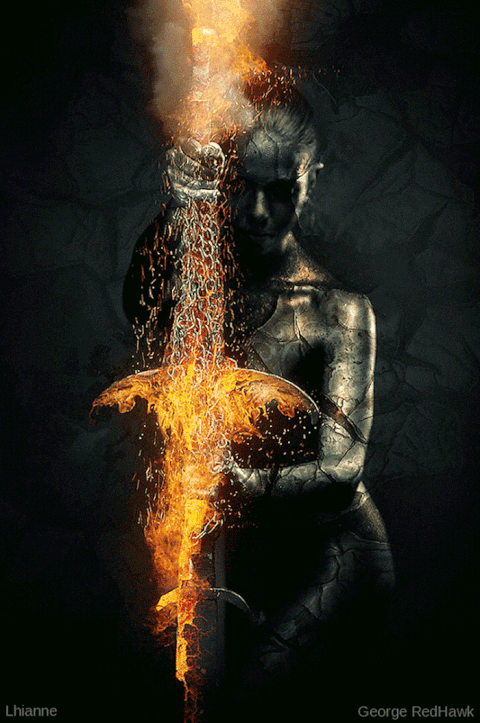
Baron Samedi is the leader of the Gede, lwa with particular links to magic, ancestor worship and death. These lesser spirits are dressed like The Baron and are as rude and crude but not nearly as charming as their master. They help carry the dead to the underworld

As well as being the master of the dead, Baron Samedi is also a giver of life. He can cure mortals of any disease or wound, so long as he thinks it is worthwhile. His powers are especially great when it comes to Vodou curses and black magic. Even if somebody has been afflicted by a hex that brings them to the verge of death, they will not die if The Baron refuses to dig their grave. So long as The Baron keeps them out of the ground, they are safe.
In many Haitian cemeteries, the longest standing grave of male is designated as the grave of Baron Samedi. A cross (the kwa Bawon, meaning "Baron's cross") is placed at a crossroads in the cemetery to represent the point where the mortal and spiritual world cross. Often, a black top hat is placed on top of this cross.
He also ensures that all corpses rot in the ground to stop any soul from being brought back as a zombie. What he demands in return depends on his mood. Sometimes he is content with his followers wearing black, white or purple clothes or using sacred objects; he may simply ask for a small gift of cigars, rum, black coffee, grilled peanuts, or bread. But sometimes The Baron requires a Vodou ceremony to help him cross over into this world

#baron samedi#lwa#african#afrakan#kemetic dreams#africans#afrakans#african culture#afrakan spirituality#haiti
164 notes
·
View notes
Text
The Resilient Spirit of Haiti: From Revolution to Modern Struggles

Haiti’s history is a testament to the resilience and courage of its people. From the first successful slave revolt that led to its independence to the complex and often turbulent politics of the modern era, Haiti has faced challenges with a spirit of resistance and a desire for sovereignty.
The Dawn of Freedom
The journey to independence was marked by the legendary Haitian Revolution against France. Beginning in 1791, enslaved Africans on the island rose against their colonizers, leading to a brutal war. Under leaders like Toussaint L’Ouverture, Jean-Jacques Dessalines, and Henri Christophe, Haiti declared independence in 1804, becoming the first black republic to free itself from the shackles of slavery. This victory was not just a local triumph but a beacon of hope for oppressed peoples everywhere.
The Price of Liberty
However, freedom came at a cost. France demanded reparations for the loss of its colony and the slaves who had been freed, imposing a crippling debt on the new nation. Haiti agreed to pay France 150 million francs, a sum that significantly hampered its economic development for generations. This debt to France, later reduced to 90 million francs, was akin to a punishment for daring to take a stand against oppression, a yoke that Haiti carried well into the 20th century.
External Interferences and Internal Struggles
The United States and other powers have also played roles in Haiti’s post-independence struggles. The U.S. military occupation from 1915 to 1934, under the guise of stabilizing the nation, saw the extraction of significant financial resources, including the transfer of $500,000 to create what would become Citigroup. This period also set a precedent for international interference in Haiti’s affairs.
Leaders such as François “Papa Doc” Duvalier and his son Jean-Claude “Baby Doc” Duvalier ruled Haiti through decades of dictatorship, marked by repression and human rights abuses. The democratic election of Jean-Bertrand Aristide in 1990 represented a glimmer of hope, but his presidency was marred by coups and controversy, reflecting the ongoing struggle for stable governance in the face of external manipulation.
The Assassination of Jovenel Moïse
The assassination of President Jovenel Moïse in July 2021 plunged Haiti into deeper turmoil. Conspiracy theories abound regarding the motives behind his murder, with some suggesting that Moïse’s attempts to challenge foreign and domestic elites’ control over Haiti’s resources led to his downfall. His death and the subsequent installation of Ariel Henry as Prime Minister have been viewed by many as yet another instance of foreign interference, with Henry labeled by some as an “international puppet.”
The Rise of Jimi "Barbecue" Cherizier
Amidst this backdrop, a new figure has emerged: Jimi “Barbecue” Cherizier. Viewed by his supporters as a revolutionary fighting for the rights of the Haitian people, Cherizier’s rise symbolizes the latest chapter in Haiti’s long history of resistance against external domination and internal corruption. However, his portrayal in the international media as a gang leader underscores the ongoing narrative battles that shape perceptions of Haiti’s struggle for sovereignty and justice.
Conclusion
Haiti’s history is rich and complex, filled with episodes of incredible bravery and grave injustices. The nation’s journey from the world’s first black republic to its current state reflects a broader struggle for autonomy, justice, and dignity. While the future remains uncertain, the enduring spirit of the Haitian people suggests that their fight for a fairer, more equitable nation continues unabated.
Contact Us :
Address – Florida
Phone - (239) 280-5554
Email - [email protected]
Website - The Kingdom Press
Blog - The Resilient Spirit of Haiti: From Revolution to Modern Struggles
4 notes
·
View notes
Text
The Cannibal Haiti gang leader ‘Barbecue’ was spotted wearing his favorite necklace. Get prepared to witness a story that was already planned get created in your face. Barbecue le chef de gang Jimmy Cherisier qui menace d’une guerre civile a prévenu mardi 11 mars 2024 que si le Premier ministre haïtien Ariel Henry restait au pouvoir, il y aurait une guerre civile.

Proclamation de l’indépendance le 1er janvier 1804 Jean-Jacques Dessalines. D'autres on succédés les plus marquants sont la famille Duvalier de 1957 à 1971 François Duvalier dit Papa Doc, puis son fils Jean-Claude Duvalier, dit « Baby Doc », qui lui succède et qui se maintient au pouvoir comme président à vie jusqu'en 1986. Les militaires dirige le pays création du CNG composé de quatre militaires et de deux civils, respectivement le Lieutenant Général Henri Namphy, président 7 février 1988 le régime militaire du général Henri Namphy était obligé d’organiser des élections générales, puis une succession de généraux ont succédé avant l'arrivée de Jean-Bertrand Aristide de 1991 à 1996 renversé et de 2001 à 2004 vint Gérard Latortue 12 mars 2004.
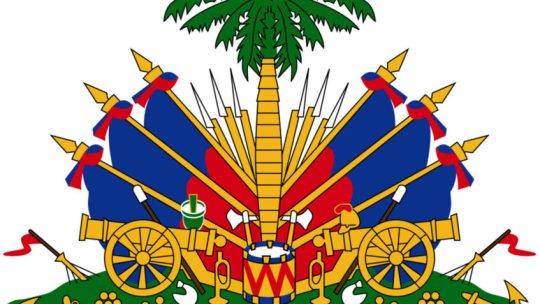
2 notes
·
View notes
Note
Re: the semi-anti Killmonger propaganda
OG Anon here. Sorry, I think I might have not come off as I intended in the original ask. It took me a bit to find a way to word it better but basically:
I don’t know what was the writers intent, but I think there’s room for some charitability, which plays into why I’m calling it semi-anti propaganda.
The movie I think does a great job setting up and portraying why he, rightly, wants a revolution. The issue is his actions around that (being a total asshole) and his end goal, which is just neo-colonialism with either Wakandas or black people more broadly in power (I’m not sure that’s ever totally clarified) instead of a more anti-imperialist approach.
The room for charitably I’d say comes from the fact that there are several historical figures that much like Killmonger have a veneer of leftist revolutionary movements of, justifiably and rightfully, fighting back against oppression but that in ideology and, if they do get into power, practice are just dictators rehashing the same structures of powers that previously oppressed them unto others. An example could be like François Duvalier in Haiti.
That historical context is basically where the anti- side of this starts and ends for me. Even if we were charitable and said his portrayal was an honest attempt to criticize these historical figures it falls into an issue of both why and why now. Regardless of their intention I 100% agree that the result is both once again showing revolutionary movements as an inherently bad thing and stoking right-wing propaganda that if oppressed groups rise up they will be as oppressive to them as they had been previously.
So the reason I’m calling it semi-anti propaganda is that on the one hand his character feels more historically grounded that some of the other submissions that I’ve seen so far but on the other it still ends up as copaganda and inherently anti-revolutionary regardless of authorial intent.
I’m not sure I did a better job explaining myself here, tbh; but either way, I love him and wish they had done him better.
Overall he definitely deserves his spot here, I’m just not sure how far I think he should get.
Oh it’s okay! Ty for the re-explanation I totally get where ur coming from. :) and sorry too if I initially sounded rude in any way in my response to ur first ask
2 notes
·
View notes
Text

President René Préval (January 9, 1943 - March 3, 2017) was a Haitian politician. He was prime minister under the presidency of Jean-Bertrand Aristide, exiled to the US, and president of Haiti (1996-2001) and (2006-11).
He was born in Port-au-Prince. The son of agronomist Claude Préval, who served as minister of Agriculture. He founded a leftist organization that resisted the François Duvalier dictatorship (1957-64).
He left Haiti in 1963 with his family for France. He attended the College of Gembloux and went to the University of Louvain to study agronomy. He went to exile in Brooklyn. He struggled to earn a living in the US as a restaurant.
He opened La Boulangerie du Centre in Port-au-Prince. He continued his commitment to politics through the radical Mouvement d’Action Démocratique. He often gave bread to the association “La famille, c’est la vie”. They became close friends and political allies. Aristide was elected president of Haiti and he chose him as prime minister.
A military coup on September 30, 1991, forced Aristide from power. He fled to DC. In 1994 the US restored Aristide to power, and he returned to become chief of the Economic and Social Action Fund.
In 1995, he became a candidate for the presidency of Haiti. He was elected with 88 percent of the vote. He continued the reforms that Aristide had begun. The relationship between both men worsened as Aristide and his followers attempted to undermine his policies. In 2001 when Aristide was again elected president, he decided to leave politics and begin farming.
In 2010, a devastating earthquake struck Haiti, killing more than two hundred thousand people and destroying Port-au-Prince. He was accused of a timid response to the disaster and of allowing corruption to undermine the reconstruction process in the nation. He left office at the end of his second term and retreated from politics. #africanhistory365 #africanexcellence
0 notes
Text
Events 1.7 (after 1960)
1968 – Surveyor program: Surveyor 7, the last spacecraft in the Surveyor series, lifts off from Cape Canaveral Launch Complex 36A. 1972 – Iberia Flight 602 crashes near Ibiza Airport, killing all 104 people on board. 1973 – In his second shooting spree of the week, Mark Essex fatally shoots seven people and wounds five others at Howard Johnson's Hotel in New Orleans, before being shot to death by police officers. 1979 – Third Indochina War: Cambodian–Vietnamese War: Phnom Penh falls to the advancing Vietnamese troops, driving out Pol Pot and the Khmer Rouge. 1980 – U.S. President Jimmy Carter authorizes legislation giving $1.5 billion in loans to bail out the Chrysler Corporation. 1984 – Brunei becomes the sixth member of the Association of Southeast Asian Nations (ASEAN). 1985 – Japan Aerospace Exploration Agency launches Sakigake, Japan's first interplanetary spacecraft and the first deep space probe to be launched by any country other than the United States or the Soviet Union. 1989 – Sutton United, a team in the fifth tier of English league football, defeated top-tier Coventry City in one of the biggest upsets in FA Cup history. 1991 – Roger Lafontant, former leader of the Tonton Macoute in Haiti under François Duvalier, attempts a coup d'état, which ends in his arrest. 1993 – The Fourth Republic of Ghana is inaugurated with Jerry Rawlings as president. 1993 – Bosnian War: The Bosnian Army executes a surprise attack at the village of Kravica in Srebrenica. 1994 – A British Aerospace Jetstream 41 operating as United Express Flight 6291 crashes in Gahanna, Ohio, killing five of the eight people on board. 1999 – The Senate trial in the impeachment of U.S. President Bill Clinton begins. 2012 – A hot air balloon crashes near Carterton, New Zealand, killing all 11 people on board. 2015 – Two gunmen commit mass murder at the offices of Charlie Hebdo in Paris, shooting twelve people execution style, and wounding eleven others. 2015 – A car bomb explodes outside a police college in the Yemeni capital Sana'a with at least 38 people reported dead and more than 63 injured. 2020 – The 6.4Mw 2019–20 Puerto Rico earthquakes kill four and injure nine in southern Puerto Rico. 2021 – The United States Congress certifies the results of 2020 United States presidential election, confirming the election of Joe Biden, on the morning of the 7th after the Capitol was attacked the day before during earlier attempts to certify the election by supporters of the incumbent president Donald Trump, who lost re-election to Biden and attempted to overturn the results of the election. 2023 – The longest U.S. House of Representatives speaker election since the December 1859 – February 1860 U.S. speaker election concludes and Kevin McCarthy is elected 55th Speaker of the United States House of Representatives.
0 notes
Text
BARON DE LA MORT [1][2][3]
Trivia & Notes
TRIVIA
An attempt was made to sketch his human form, but there are many problems with his design:
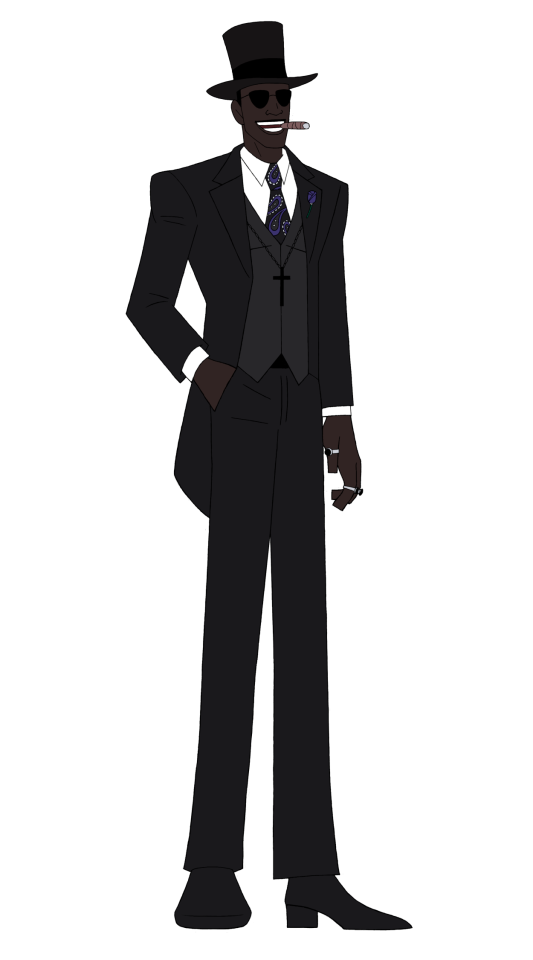
Full size
This pisses me off, so much… He literally looks like a background character.
Seriously, why is he wearing a generic purple paisley tie? He should totally have little skull details there. I think I went a little too far with the “less is more approach.” He’s so drip-less, it’s not even funny…
Two major problems with this design is that he looks too similar to François Duvalier, and that he must have a skull tattooed on his face. I was actually just drawing him cosplaying Don Corleone, but I realized too late that Duvalier dressed quite similarly to The Godfather. I have still chosen to show what he looks like without the skull tattoos, to make his facial structure visible.
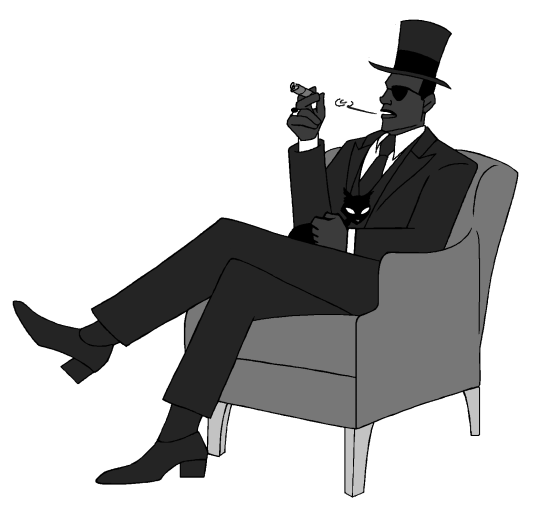
Full size
Here is another shot of his face, from a different angle. My intent was to differentiate his facial structure from Duvalier. Changes to his facial structure might be necessary, but steps must be taken to differentiate his features from the former dictator.
Previously, I had planned for him to dress similarly to Gustavo Fring in his past human life. However, I do not think that Fring’s style fits his character, as I want him to have a unique and original look. In his past human life, his distinguishing traits are supposed to be his tattoos, his taste in suits, and habitual smoking of cigars; these carry over into his next life as a god.
The skull tattooed into his face must be a very distinct design that is visually striking when the contrast is maximized in his face. This is how he forces those in his presence to look upwards–up at his face, and nowhere else. I was envisioning something somewhat like this, where he has the individual teeth inked into his face.
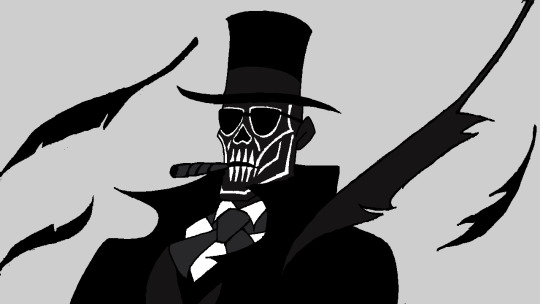
Full size
This should only be viewed as a placeholder for what should actually be tattooed onto his face; this is a horrendous concept.
His sunglasses were originally supposed to resemble Gustavo Fring’s glasses, but this sketch made me realize that the shape of his sunglasses needs to be redesigned.
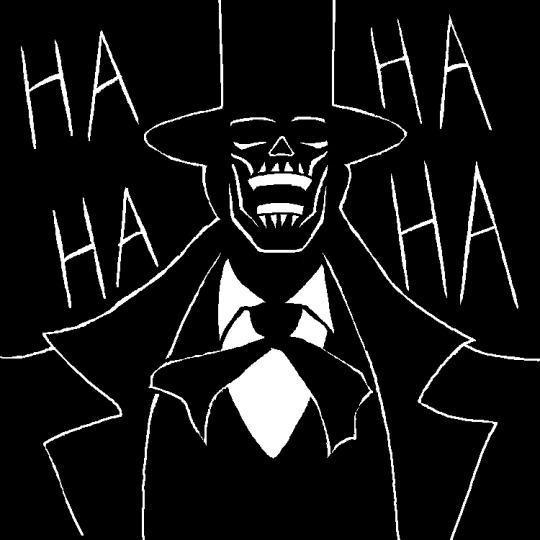
Full size
In this second sketch, I tweaked the shape of his glasses, and attempted to make the pattern around his eyes resemble tattooing instead of face paint. Again, this is merely a placeholder for what his face should actually look like, as it still looks very bad; a competent character designer is necessary to come up with a viable concept. His wife, Maman de la Vie, must also have a matching skull. Although both of them have the ability to shape-change the tattoos on their body, they can never display this ability, as they have never changed their tattoos since The Beginning of Time. For this reason, it’s very important to get the design right from the start. It has to be immediately visually apparent that he and she are the ‘boss’, the other characters are ‘underlings’.
While he is intended to be very tall, I made the height gap between him and his youngest brother too large. Big Papa likes to shapeshift his height, but in his default state he should only be about half a head shorter than Baron de la Mort. I failed here too, but his silhouette is supposed to resemble an ominous obelisk, in the form of a large rectangle.
As far as introductions go, I think the coolest way to introduce this guy would be to build up to him ripping someone’s soul apart. The character remains shrouded in mystery, as one of his henchmen is revealed. The henchman is very powerful, but nothing more than a tool who is trapped in a horrible soul deal with his soul owner. After revealing the henchman, many other details can be revealed about The Baron, including his powers, personality, and backstory.
Although his Signature Move has a name (“Eternal Torment”) he does not call his attacks; it’s just something he might say during his monologue before executing the attack.
The parts of his suit that appear to be grey are actually a dark and desaturated shade of purple.
The Baron’s ability to scale his height is inspired by the following description of Baron Samedi[32]:
“Loi Ba-un-Samedi (? gives or for Saturday). He is like Ogun, but “worse”, he is a grande diable. He makes all kinds of motions to make you laugh, but you must not laugh at him, for if you do, he makes you " stop laughing ", which means inversely that he makes you go on laughing forever against your will. Anything you touch, he takes and never returns, and you have to give him more and more. He smokes cigarettes, not cigars. He wears a coat and hat, and carries a stick. He can make himself short or tall, " as tall as a mast”.”
However, he smokes cigars instead of cigarettes, to make him look like Andre Pierre’s portrait of Baron Samedi, and a One Piece character.
Although his D&D Alignment is ‘True Neutral’, he is supposed to look like a One Piece villain—specifically Donquixote Doflamingo and Crocodile (One Piece). This is why he laughs. He is also inspired by Gomez Addams and Don Corleone, as he is portrayed in The Godfather novel and films. His skeleton form is inspired by Skull Knight (Berserk).
According to Milo Marcelin’s description, Baron Samedi is said to have a notoriously bad temper. Underneath his outward persona, Baron de la Mort actually has near-perfect control over his emotions… unless you kill his wife. Then he completely loses his mind. In this sense, he also has a horrible temper.
Several things differentiate Baron de la Mort and Maman de la Vie from their siblings, including (1) their names, which break the song-themed naming scheme (2) their tattoos, which normally hide their skin color (3) their status as pariahs among the gods, where they dwell in their own realm, and so on. These differences serve to signify their special status as The gods of Life and Death. It was also to facilitate pulling them out of the Original Seven Creations, if necessary, to make them something like “secret bosses” – the only two other beings to achieve godhood, who were created at a much later time: when Lucifer gave humanity Free Will, creating the realm of Hell.
As the two "Devils", Baron de la Mort is designed to contrast with Big Papa; the former is mostly inspired by mythology from Haitian Vodou, while the latter is mostly inspired by folklore from New Orleans Voudou. Big Papa has a canine motif; Baron de la Mort has a feline motif. In spite of his name, Big Papa is not a good father figure; Baron de la Mort surprisingly is. Big Papa is the least interested in marriage; Baron de la Mort and Maman de la Vie are not just married in their present immortal lives, but in their past lives as humans. They are also the only two who have children–adopted, as they are forbidden from conceiving another god.
His adoptive family is supposed to be a cross between the Addams Family and the Don Quixote Pirates. Except, not exactly the Don Quixote Pirates (Doflamingo literally had Senor Pink on his pirate crew…) They all have wildly different personalities and silhouettes, as they are inspired by Milo Marcelin’s Mythologie Vodou. Each of these adult children has two outfits (1) a black outfit, where they all match; more formal and used for family portraits (2) purple outfits, which express their unique personalities; more casual and frequently worn. They do not tattoo, but paint skulls on their faces. The face paint washes off, to the point where it doesn’t even look like a skull anymore; for lack of better word, it just looks like a “blob”. They are much more comedic than their adoptive parents, and would fit a lot more easily into a light-hearted tone. As they are essentially a comedy band, the individual members have funny personalities, which is enhanced by how they clash with each other. Because of this, it is easy to forget how powerful they are; they are basically a set of Ten Superweapons.
Baron de la Mort’s name is written in French for an English-speaking audience, who knows his real-life counterpart as Baron Samedi instead of Bawon Samdi. Should his name be localized to Kreyòl, it should become Bawon Lanmò; in a sense, this is his true name. So not to give them the same name, the name of his underling should be changed in the localization from Lanmò to Mouri.
The Baron’s staff was visually inspired by artwork from the In Extremis display at the UCLA Fowler Museum. Also inspired the In Extremis display, Baron de la Mort and Maman de la Vie are supposed to resemble ‘skeletons’, while their children and underlings resemble ‘rotten flesh’.
He adopted ten adult children, named after the capitals of the departments of Haiti. The duration of adoption and power level of each child is ranked according to the land area of each department, with the exception of Port-au-Prince, who is the weakest and most recently adopted.
When he collapses them down into particles, the Black Holes of Torture are actually sent to the Dungeon of his Castle in the Underworld. It is a room full of Black Holes, kind of like the Bubble Room in Steven Universe, but full of people screaming in agony for eternity. At intervals, he randomly selects some of the Black Holes and expands them, then crushes them back down into single particles, causing excruciating pain to whoever is trapped inside. Sometimes, Maman de la Vie does this instead, as she also has this power. This was inspired by Crocodile (One Piece)’s Conference Room, which is actually a torture dungeon.
Whenever he takes off his sunglasses, another pair of sunglasses instantly appears under his sunglasses.
He is called “Heavenly Judge” because Baron Samedi is referred to as “juge di ciel” (“heavenly judge”) [33]:
Baron Samedi quembe n’homme na! Pinga langue’l n’homme na! Pinga lague’l, juge di ciel, quembe n’homme na! Pinga lague’l, Baron Samedi, quembe n’homme na! Pinga lague’l, juge di ciel, quembe n’homme na! Pinga lague’l, Baron Samedi, quembe n’homme na! Pinga lague’l, juge di ciel, quembe n’homme na! Baron Samedi quembe n’homme na, pinga lague’l!
Baron Samedi hold that man! Don’t let him go! Don’t let him go, heavenly judge, hold that man! Don’t let him go, Baron Samedi, hold that man! Don’t let him go, heavenly judge, hold that man! Don’t let him go, Baron Samedi, hold that man! Don’t let him go, heavenly judge, hold that man! Baron Samedi hold that man, don’t let him go!
NOTES
Herskovits, Melville Jean, and Herskovits, Frances Shapiro. Dahomean Narrative: A Cross-cultural Analysis. United States, Northwestern University Press, 1970. Originally published in 1958. p. 124. Retrieved from: https://archive.org/details/dahomeannarrativ0000hers/page/124/mode/2up
For the origins of the Gede rite, see: Hebblethwaite, Benjamin. A transatlantic history of Haitian Vodou: rasin figuier, rasin Bwa Kayiman, and the Rada and Gede Rites . Univ. Press of Mississippi, 2021.
For a theory regarding the origins of Baron Samedi, see: Smith, Katherine, and Donald Cosentino. "Genealogies of Gede." In Extremis: Death and Life in 21st-Century Haitian Art (2012): 84-99.
In several of his writings, the American novelist Harold Courlander claimed that Gede Nibo is considered the same as Baron Samedi in some regions of Haiti: “In Mirebalais, Dr. Herskovits received the impression that Gede Nimbo and Baron Samedi are different loa. In the south they are considered the same.” SOURCE: Courlander, Harold. Haiti Singing. United States, Cooper Square Publishers, 1973. Originally published in 1939. Retrieved from: https://archive.org/details/isbn_0815404611/page/34/mode/1up; Similar comments were by the American authors Maya Deren, Zora Neale Hurston, and Katherine Dunham; however, this was not observed by Dr. Elsie Clews Parsons, who recorded folklore from the southern coast of Haiti and clearly distinguished Gede Nibo (“Gede-nibo”) from Baron Samedi (“Ba-un-Samedi”) SOURCE: PARSONS, Elsie Clews. “SPIRIT CULT IN HAYTI.” Journal de La Société Des Américanistes, vol. 20, 1928, pp. 157–79. JSTOR, http://www.jstor.org/stable/24720068. Accessed 26 Dec. 2024. Due to inconsistent information, I am uncertain whether this is a real regional difference, or a foreign misconception.
Several people disagree with how Beauvoir classified all of the lwa; other sources still separate Baron Samedi from Gede Nibo, but may define fanmi differently from him: Beauvoir, Max. Lapriyè Ginen. Haiti, Edisyon Près Nasyonal d'Ayiti, 2008. pp. 187-196. https://archive.org/details/beauvoir-max-g.-lapriye-ginen-2008/page/n97/mode/2up.
For a description of Papa Gede, see: Brown, Karen McCarthy. Mama Lola: A vodou priestess in Brooklyn . Vol. 4. Univ of California Press, 2010; See also: Marcelin, Milo. Mythologie vodou (rite arada). Vol. 2. Éditions Canapé-Vert, Pétionville, Haiti, 1950. pp. 181-190. Retrieved from: https://ufdc.ufl.edu/AA00005044/00002/images/180
Mocombe, Paul C. “Practical Reason in Haitian Idealism: Anti-Dialectics, Reciprocal Justice, and Afeminism Epistemology.” Race, Gender & Class 25, no. 1–2 (2018): 31–47. https://www.jstor.org/stable/26649532.
Marcelin, Milo. Mythologie vodou (rite arada). Vol. II. Éditions Canapé-Vert, Pétionville, Haiti, 1950. pp. 153-171. Retrieved from: https://ufdc.ufl.edu/AA00005044/00002/images/152
Brown, Karen McCarthy. Mama Lola: A vodou priestess in Brooklyn . Vol. 4. Univ of California Press, 2010.
"Lesson Two: Gede and the Cemetery." In Extremis: Death and Life in 21st-Century Haitian Art – Curriculum Resource Unit. Retrieved from: https://fowler.ucla.edu/wp-content/uploads/2021/08/InExtremis_CRU.pdf
Cosentino, Donald. Sacred Arts of Haitian Vodou. United States, UCLA Fowler Museum of Cultural History, 1995. pp. 406-407 https://archive.org/details/sacredartsofhait0000unse/page/406/mode/2up
Anderson, Jeffrey E.. Voodoo: An African American Religion. United States, LSU Press, 2024.
Puckett described this figure like so: ““...Most of the time, however, when going about on the earth, the Negro devil has the appearance of a gentleman, wearing a high silk hat, and a frock coat, and having an "ambrosial curl" in the center of his forehead to hide the single horn which is located there. Mrs. Viriginia Frazer Boyle tells me that when she was first taken to church by her father and mother she used to scan the congregation eagerly for a man with that "ambrosial curl" and one with the "evil eye", which her old Negro nurse had told her were to be found in every crowd, even in church. In most cases this Negro devil has cloven feet, a characteristic also credited to him in European circles. Possibly the black cat is the animal most chosen by the Negro devil for impersonation...Nevertheless the devil is not limited to this particular form but may appear as a rabbit, terrapin, serpent, housefly, grasshopper, toad, bat, or yellow dog at will. To the Mississippi Negroes he often appears as a black billy-goat; a view strictly in keeping with his custom at the English witches' Sabbath. In New Orleans it is thought by some that snakes and black cats are incarnations of the devil…” SOURCE: Puckett, Newbell Niles. Folk beliefs of the southern Negro. University of North Carolina Press, 1926. https://archive.org/details/folkbeliefsofsou00puck/page/550/mode/2up; An additional description is provided by Jacobsen: “A figure very similar to the Haitian Ghede and Puckett’s Negro Devil appears in many Woodruff County folktales. He is commonly seen near a crossroads, a cemetery, or, as is often the case, both simultaneously. Sometimes, as in Haiti, he holds a cane.” SOURCE: Jacobsen, K. (Nov. 1, 2002). The Society for the Study of Southern Literature, Volume 36, Issue 1: https://southernlit.org/volume-36-issue-one-fall-2002/; although Jacobsen likens him to Ghede, his manner of dress actually matches Milo Marcelin’s description of Baron Samedi: “Baron-Samedi, père et chef des Guédé, est le maître des cimetières. On le représente sous les traits d’un noir robuste, qui porte une longue barbe blanche; il est vêtu d’une redingote, coiffé d’un melon ou d’un chapeau haut de forme, ganté de blanc; il a toujours en main un bâton coco-macaque et une bouteille de clairin ou rhum blanc. Une croix noire, sur laquelle figure parfois un crâne, est son Emblème.” SOURCE: Marcelin, Milo. Mythologie vodou (rite arada). Vol. II. Éditions Canapé-Vert, Pétionville, Haiti, 1950. p. 153. Retrieved from: https://ufdc.ufl.edu/AA00005044/00002/images/152
This song is from the following play: Déjoie, Menès. (2016). Masuife. Createspace Independent Publishing Platform. Retrieved from: https://archive.org/details/masuife/page/n26/mode/1up
Milo Rigaud described Jean Zombi in the following terms: “Jean Zombi est un des prototypes les plus curieux de la Tradition voudoo. Il fut un de ceux qui, d'ordre de Dessalines. massacrèrent le plus de blancs pendant la libération d'Haïti du joug français. Jean Zombi est actuellement un des mystères les plus influents du panthéon voudoesque : comme loa, il appartient au rite Péthro”. Source: Rigaud, Milo. La tradition voudoo et le voudoo haïtien: son temple, ses mystères, sa magie. FeniXX, 1953. P. 67. https://lib-ufdcweb3.uflib.ufl.edu/AA00002240/00001/70x; Milo Marcelin described Captain Zombi in the following terms: “Cap'taine Guédé ou Cap'taine Zombi est un loa élégant et sinistre. On se le représente comme un homme vêtu de blanc, bien cravaté et badine à la main. Sa mâchoire est bandée comme celle d'un cadavre et il a du coton dans les narines et les oreilles…” Source: Marcelin, Émile, and Alfred Métraux. "LES GRANDS DIEUX DU VODOU HAIÏTIEN." Journal de la Société des Américanistes 36 (1947): 51-135. https://www.persee.fr/doc/jsa_0037-9174_1947_num_36_1_2357; Jean Zombi (Jan Zonbi) and Captain Zombi (Kaptèn Zonbi) are also listed in Beauvoir’s Lapriyè Ginen, under the Gede rite: Beauvoir, Max. Lapriyè Ginen. Haiti, Edisyon Près Nasyonal d'Ayiti, 2008. pp. 187-196. https://archive.org/details/beauvoir-max-g.-lapriye-ginen-2008/page/n97/mode/2up
These lyrics can be found in: Anderson, Jeffrey E.. Voodoo: An African American Religion. United States, LSU Press, 2024; according to Anderson, they were reported in a newspaper from New Orleans. A similar song is described in Helen Pitkin Scherz’s fictional novel An Angel by Brevet, although instead of “Pou fé mouri” the lyrics go “L’appé vini, li grand Zombi, L’appé vini pou to gri-gri”. The novel also contains a second song that seems to connect “Zombi” to “La Mort” (Death). As other songs in this novel are attested by non-fiction sources, it is possible this too was a real song. See: Schertz, Helen Pitkin. An Angel by Brevet: A Story of Modern New Orleans. United Kingdom, J.B. Lippincott, 1904. p. 61 & pp. 285-286. Retrieved from: https://www.google.com/books/edition/An_Angel_by_Brevet/35PUAAAAMAAJ?hl=en&gbpv=0
The book El vodú en Cuba describes how vodou was practiced by Haitians who immigrated to Cuba during the early 20th century. One of the lwa is named “Zombí”, who is an old, wrinkled man who lives in the woods, wearing a torn hat and rolled up pants. Source: James Figarola, Joel, José Millet, and Alexis Alarcón. El vodú en Cuba. Santiago de Cuba: Editorial Oriente, 2007. Originally published in 1998. pp. 174-175. https://archive.org/details/elvoduencuba0000jame/page/174/mode/1up
Luisah Teish identified Grand Zombi with the rainbow serpent Dan Aidowedo: Teish, Luisah. Jambalaya: The Natural Woman's Book of Personal Charms and Practical Rituals. United States, HarperCollins, 2021. Originally published in 1985; Curator of The New Orleans Historic Voodoo Museum, Jerry Gandolfo, claims to have witnessed a secret ceremony in which Grand Zombi (“Le Grande Zombie”) was represented by a live serpent: Crocker, Elizabeth Thomas. A trinity of beliefs and a unity of the sacred: modern Vodou practices in New Orleans. Louisiana State University and Agricultural & Mechanical College, 2008; Denise Alvarado describes Grand Zombi as “the primary serpent deity of New Orleans Voudou”: Alvarado, Denise. Witch Queens, Voodoo Spirits, and Hoodoo Saints: A Guide to Magical New Orleans. United States, Red Wheel/Weiser, 2022; Carolyn Morrow Long proposed that Grand Zombi might be derived from “Nzambi Mpungu, the supreme being of the Kongo people”: Long, Carolyn Morrow. A New Orleans Voudou Priestess: The Legend and Reality of Marie Laveau. United States, University Press of Florida, 2007.
Schertz, Helen Pitkin. An Angel by Brevet: A Story of Modern New Orleans. United Kingdom, J.B. Lippincott, 1904. pp. 273-275. Retrieved from: https://www.google.com/books/edition/An_Angel_by_Brevet/35PUAAAAMAAJ?hl=en&gbpv=0; The novel describes a song for Charlo on pages 273 and 274, in which he is referred to as “Charlo, ‘tit’ frère.”
See: Garrigus, John D.. A Secret Among the Blacks: Slave Resistance Before the Haitian Revolution. United States, Harvard University Press, 2023, p. 92. https://www.hup.harvard.edu/books/9780674272828; For historic descriptions of Charlot, see: Charles Fournier de la Chapelle, “Mémoire pour servir à l’information des procés contre les négres devins, sorciers et empoisonneurs” (1758). Retrieved from: https://gallica.bnf.fr/ark:/12148/btv1b10112297j/f6.item; and: Sébastien Jacques Courtin. “Mémoire Sommaire Sur Les Prétendus Pratiques Magiques et Empoisonnements Prouvés Au Procès Instruit et Jugé Au Cap Contre Plusieurs Nègres et Négresses Dont Le Chef Nommé François Macandal a Été Condamné Au Feu et Exécuté Le Vingt Janvier Mille Sept Cents Cinquante Huit,’ 1758, ANOM F/3/88,” January 20, 1758. Archives Nationales d’Outre Mer. Retrieved from: https://ecda.northeastern.edu/key-text-memoire-sommaire-sur-les-pretendus-pratiques-magiques-et-empoisonnements/; I have attempted to transcribe excerpts of these documents here: https://archiveofourown.org/works/54861145/chapters/156619222
Albert J. Raboteau describes evidence of Shango or Xɛbyoso in Slave Religion: Raboteau, Albert J. Slave religion: The" invisible institution" in the antebellum South. New York: Oxford University Press, 1978. pp. 80-81. Retrieved from https://archive.org/details/slavereligioninv00rabo/page/80/mode/2up; The lightning stones seized from the home of Betsy Toledano might have been sokpe, possible evidence of Xɛbyoso worship. See: Ellis, Alfred Burdon. The Eʻwe-speaking Peoples of the Slave Coast of West Africa: Their Religion, Manners, Customs, Laws, Languages, &c. United Kingdom, Chapman and Hall, limited, 1890. p. 38 Retrieved from: https://www.google.com/books/edition/The_E%CA%BBwe_speaking_Peoples_of_the_Slave/Ak9M8SXJlekC?hl=en&gbpv=0; Xɛbyoso also appears in the pantheon of Haitian Vodou, as Kebyesou Danle (Xɛbyoso dans l’air / Xɛbyoso in the air) or Kebyezo. Granted, Toledano was not necessarily a priestess of Xɛbyoso, as similar stones were also used in the worship of Shango. See Courlander’s description of “loa stones” / “thunder stones” in: Courlander, Harold. The Drum and the Hoe: Life and Lore of the Haitian People. United States, University of California Press, 1960. Retrieved from: https://archive.org/details/drumhoe0000unse/page/21/mode/1up; Alvarado also proposes that Toledano might have worshiped Shango instead of Xɛbyoso in: Alvarado, Denise. Witch Queens, Voodoo Spirits, and Hoodoo Saints: A Guide to Magical New Orleans. United States, Red Wheel/Weiser, 2022; For more information about the central role of Xɛbyoso in the Dahomean pantheon, see: Herskovits, Melville Jean. Dahomey, an Ancient West African Kingdom, Vol. II. Evanston, Northwestern University Press, 1967. pp. 150-169. Retrieved from: https://archive.org/details/dahomeyancientwe0000hers/page/150/mode/2up; and: Herskovits, Melville Jean, and Herskovits, Frances Shapiro. Dahomean Narrative: A Cross-cultural Analysis. Evanston, Northwestern University Press, 1958. Retrieved from: https://archive.org/details/dahomeannarrativ0000hers.
Ahoga, Cossi Augustin. Vers un modèle africain de dialogue interreligieux: Le cas de Vodun Xɛbyoso et de l’Église des Assemblées de Dieu dans la région Maxi au Bénin. United Kingdom, Langham Creative Projects, 2023; As described by Ellis, “flint implements of the Stone Age” were believed to be the thunderbolts of Xɛbyoso, and were thusly called “so-kpe” – “thunder stones”: Ellis, Alfred Burdon. The Eʻwe-speaking Peoples of the Slave Coast of West Africa: Their Religion, Manners, Customs, Laws, Languages, &c. United Kingdom, Chapman and Hall, limited, 1890. p. 38 Retrieved from: https://www.google.com/books/edition/The_E%CA%BBwe_speaking_Peoples_of_the_Slave/Ak9M8SXJlekC?hl=en&gbpv=0; This is just speculation, but worshipers of Xɛbyoso and their descendants might have identified the flint implements of Native Americans with so-kpe, establishing another connection between West African and Native American cultures through the “thunder bird”.
Owen, Mary Alicia. Voodoo Tales: As Told Among the Negroes of the Southwest. United States, Putnam's Sons, 1893. https://www.google.com/books/edition/Voodoo_Tales/H_kLAAAAYAAJ?hl=en&gbpv=0
In describing the contradictory narratives surrounding Marie Laveau, Kodi A. Roberts mentions that “She was also remembered as sheltering both African slaves and Native Americans at her home. Some of these, especially the Native Americans, are remembered as traders with whom Laveau had some kind of business relationship, adding the role of entrepreneur to her other accomplishments”. Source: Roberts, Kodi A.. Voodoo and Power: The Politics of Religion in New Orleans, 1881-1940. United States, LSU Press, 2015.
The “Mardi Gras Indians” are part of the Black masking tradition of New Orleans, as a tribute to the positive history between Native Americans and African Americans: “In 1722, the first known escape of a slave from a plantation took place. It is said that tribes such as the Choctaw, Seminoles, and Chickasaws in Louisiana were responsible for freeing some of the Africans from slavery. With Indian help, the Africans learned to survive off the land and lived in the forest camps that came to be known as Maroon Camps…They relied on the Indians to help negotiate the swamps and continued cultivating their relationship with them, even establishing a sort of Underground Railroad to the maroon camps where possible. At this time, the Africans were very thankful to have such allies, and in 1746, archives began to refer to slaves dressing as Indians as the Africans began to celebrate Mardi Gras in their unique customary fashion.” Source: The Mardi Gras Indians, a story. African American Registry. 13 Feb. 2024. Accessed December 29, 2024 from https://aaregistry.org/story/the-mardi-gras-indians/; The article also describes how hundreds of enslaved Africans and Indians (enslaved and free) joined forces in the “Natchez Revolt” of 1729. Marronage is a key aspect to the history of Louisiana Voudou, with San Maló being one of the most important saints. See: Voisin, Erin Elizabeth. Saint Maló Remembered. Louisiana State University and Agricultural & Mechanical College, 2008.
The word zonbi might be African in origin; see: Hans-W. Ackermann, and Jeanine Gauthier. “The Ways and Nature of the Zombi.” The Journal of American Folklore, vol. 104, no. 414, 1991, pp. 466–94. JSTOR, https://doi.org/10.2307/541551. Accessed 30 Dec. 2024.
Davis, E. Wade. “PREPARATION OF THE HAITIAN ZOMBI POISON.” Botanical Museum Leaflets, Harvard University, vol. 29, no. 2, 1983, pp. 139–49. JSTOR, http://www.jstor.org/stable/41762846. Accessed 30 Dec. 2024.
Marcelin, Milo. Mythologie vodou (rite arada). Vol. II. Éditions Canapé-Vert, Pétionville, Haiti, 1950. pp. 156-157. Retrieved from: https://ufdc.ufl.edu/AA00005044/00002/images/155
International Gay and Lesbian Human Rights Commission (IGLHRC) and SEROVie. "The impact of the earthquake, and relief and recovery programs on Haitian LGBT people." (2011). Retrieved from: https://iglhrc.org/sites/default/files/505-1.pdf
Quoting Charlot Jeudy, the former President of KOURAJ: “After we were in 2010, with the massive earthquake that struck the country and brought destruction on all of us. And we saw a large number of Western evangelicals, especially from the United States, arrive under the pretext of preaching the gospel and the return of Christ. This soon became preaching homophobia and hate towards our community M, blaming the earthquake that had struck the country on sex between men, between women. Don’t forget that 65% of the country was illiterate and didn’t have any deep understanding behind the cause of seismic movements.…Many other friends found themselves in the camps for 2 or 3 months after the earthquakes and in them our Republic became more of a theocracy run by the religious. Everyone was preaching and the preachers were foremost attacking gays and transsexuals…Those in the camps were being heavily persecuted and forced to leave to find shelter elsewhere due to what was coming from these preachers (saying they were sinners, etc.).” SOURCE: A Cases Rebelles’ conversation with Charlot Jeudy, President, Executive Committee of Kouraj (Haiti), Retrieved from: https://www.q-zine.org/non-fiction/kouraj/
Marcelin, Milo. Mythologie vodou (rite arada). Vol. II. Éditions Canapé-Vert, Pétionville, Haiti, 1950. pp. 194. Retrieved from: https://ufdc.ufl.edu/AA00005044/00002/images/193
PARSONS, Elsie Clews. “SPIRIT CULT IN HAYTI.” Journal de La Société Des Américanistes , vol. 20, 1928, pp. 157–79. JSTOR , http://www.jstor.org/stable/24720068 . Accessed 18 Sept. 2024.
Courlander, Harold. Haiti Singing. New York, Cooper Square Publishers, Inc., 1973. Originally published in 1939 by University of North Carolina Press. pp. 87-88. Retrieved from: https://archive.org/details/isbn_0815404611/page/87/mode/1up
0 notes
Text
Today's selected anniversaries: 22nd September 2024
1789:
The office of United States Postmaster General was formally established. https://en.wikipedia.org/wiki/United_States_Postmaster_General
1957:
François Duvalier, nicknamed Papa Doc, was elected President of Haiti as a populist before consolidating power and ruling as a dictator for the rest of his life. https://en.wikipedia.org/wiki/Fran%C3%A7ois_Duvalier
2003:
Dolphin, the first emulator for the GameCube that could run commercial video games, was released. https://en.wikipedia.org/wiki/Dolphin_%28emulator%29
2013:
Insurgency in Khyber Pakhtunkhwa: All Saints Church in Peshawar, Pakistan, was attacked by two suicide bombers who killed 127 people. https://en.wikipedia.org/wiki/Peshawar_church_bombing
0 notes
Text
0 notes
Text
François Duvalier - Wikipedia
An undercover government death squad, the Tonton Macoute (Haitian Creole: Tonton Makout), indiscriminately tortured or killed Duvalier's opponents; the Tonton Macoute was thought to be so pervasive that Haitians became highly fearful of expressing any form of dissent, even in private. Duvalier further sought to solidify his rule by incorporating elements of Haitian mythology into a personality cult.
MOCRO MAFFIA
0 notes
Text
L'origine contemporaine des gangs armés en Haïti
Résumé L’histoire des gangs armés aussi connus sous le nom de troupe de malfaiteurs ou de bande criminelle, en Haïti, ne date pas d’aujourd’hui. Car, elle s’inscrit depuis l’origine dans l’histoire du pays (Alcin, et al., 2023). Néanmoins, pendant la période contemporaine, elle remonte à la période de François Duvalier suite à la création des Volontaires de la Sécurité Nationale (VSN) en 1959…
View On WordPress
0 notes
Link
In April 1971, François Duvalier died and was replaced by his teen-age sonJean-Claude. We are not going to go into the politics of this succession. We willjust note that in the decade that followed, foreign aid flowed, and noticeablechanges happened in the lifestyle of the elites and the middle classes,developing, amon
0 notes
Text
The Resilient Spirit of Haiti: From Revolution to Modern Struggles

LEARN YOUR HISTORY
youtube
Haiti’s history is a testament to the resilience and courage of its people. From the first successful slave revolt that led to its independence to the complex and often turbulent politics of the modern era, Haiti has faced challenges with a spirit of resistance and a desire for sovereignty.
The Dawn of Freedom
The journey to independence was marked by the legendary Haitian Revolution against France. Beginning in 1791, enslaved Africans on the island rose against their colonizers, leading to a brutal war. Under leaders like Toussaint L’Ouverture, Jean-Jacques Dessalines, and Henri Christophe, Haiti declared independence in 1804, becoming the first black republic to free itself from the shackles of slavery. This victory was not just a local triumph but a beacon of hope for oppressed peoples everywhere.
The Price of Liberty
However, freedom came at a cost. France demanded reparations for the loss of its colony and the slaves who had been freed, imposing a crippling debt on the new nation. Haiti agreed to pay France 150 million francs, a sum that significantly hampered its economic development for generations. This debt to France, later reduced to 90 million francs, was akin to a punishment for daring to take a stand against oppression, a yoke that Haiti carried well into the 20th century.
External Interferences and Internal Struggles
The United States and other powers have also played roles in Haiti’s post-independence struggles. The U.S. military occupation from 1915 to 1934, under the guise of stabilizing the nation, saw the extraction of significant financial resources, including the transfer of $500,000 to create what would become Citigroup. This period also set a precedent for international interference in Haiti’s affairs.
Leaders such as François “Papa Doc” Duvalier and his son Jean-Claude “Baby Doc” Duvalier ruled Haiti through decades of dictatorship, marked by repression and human rights abuses. The democratic election of Jean-Bertrand Aristide in 1990 represented a glimmer of hope, but his presidency was marred by coups and controversy, reflecting the ongoing struggle for stable governance in the face of external manipulation.
The Assassination of Jovenel Moïse
The assassination of President Jovenel Moïse in July 2021 plunged Haiti into deeper turmoil. Conspiracy theories abound regarding the motives behind his murder, with some suggesting that Moïse’s attempts to challenge foreign and domestic elites’ control over Haiti’s resources led to his downfall. His death and the subsequent installation of Ariel Henry as Prime Minister have been viewed by many as yet another instance of foreign interference, with Henry labeled by some as an “international puppet.”
The Rise of Jimi "Barbecue" Cherizier
Amidst this backdrop, a new figure has emerged: Jimi “Barbecue” Cherizier. Viewed by his supporters as a revolutionary fighting for the rights of the Haitian people, Cherizier’s rise symbolizes the latest chapter in Haiti’s long history of resistance against external domination and internal corruption. However, his portrayal in the international media as a gang leader underscores the ongoing narrative battles that shape perceptions of Haiti’s struggle for sovereignty and justice.
Conclusion
Haiti’s history is rich and complex, filled with episodes of incredible bravery and grave injustices. The nation’s journey from the world’s first black republic to its current state reflects a broader struggle for autonomy, justice, and dignity. While the future remains uncertain, the enduring spirit of the Haitian people suggests that their fight for a fairer, more equitable nation continues unabated.
Contact Us :
Address - Florida
Phone - (239) 280-5554
Email - [email protected]
Website - The Kingdom Press
Blog - The Resilient Spirit of Haiti: From Revolution to Modern Struggles
0 notes
Text
A-T-3 243 Albert Chancy - Brigitte Bardot Min Pa'ou
Haitian disco. The Republican Party have stepped up their campaign of confusion and innuendo to gain control and power. Papa bullshitter Trump went on X to chat shit with baby bullshitter Tucker Carlson. The take home from the interview is Trump still wants to be a Putin style czar or Prince Mohammed bin Salman ruler, democracy is out, and he needs the support of useful idiots to do his bidding. It could work, that he might be in jail doesn't seem to be a hurdle. The medium is the message, or at least part, and the Trump interview on X was aired just ahead on the first GOP debate broadcast exclusively on Fox in the US. The candidates for the republican nomination for US president don't look like a match for Trump... so what are they doing? Some could be jostling for positions in a Trump administration, if he is successful, although that's unlikely to be the case for weirdo Mike Pence? Are they there to steer the political agenda, maybe
The track I'm posting today is from Haiti. Haiti is prone to natural disasters, it has been hit by floods and earthquakes all though the recorded history of the region. The floods are becoming more frequent though. Haiti hadn't recovered from recent previous disasters before flooding devastating it again in June 2023, then Tropical Storm Franklin hit Haiti a few days ago. The disasters are becoming more frequent due to a warming planet hastened by the burning of fossil fuels (euphemistically referred to as 'human behaviour')
Environmental disasters in Haiti are destroying its already poor infrastructure and economy, people are being displaced, many people are naturally seeking refuge in other countries and the number one historical culprit for the climate catastrophe we are in, the USA, has effectively closed its borders (have you seen those inhumane death traps Texas governor Greg Abbott has put across the Rio Grande?) US hostility towards Haitian refugees can be traced back to the time when the track I'm posting was made and an early act made by Raegan which reversed Carter's 'entrance' policy to let in Haitian 'boat people' fleeing the brutal dictatorships of François "Papa Doc" and Jean-Claude "Baby Doc" Duvalier
It's infuriating watching people putting themselves forward for essentially guardianship of the planet in the GOP debate, at a time when weather related disasters are destroying large areas of the planet, none of them had the temerity to acknowledge human made climate change, moron Vivek Ramaswamy even said "The climate change agenda is a hoax" - Maui wildfire a hoax, is it? August Complex fire, if you want an example on mainland USA?
The level of childishness and repudiation at the GOP debate was astonishing. Ron DeSantis quickly got in “Look, we’re not schoolchildren" after the panel were asked “Do you believe in human behavior is causing climate change? Raise your hand if you do” by Fox host Martha MacCallum. DeSantis is governor of Florida, as governor he participates in what they call a 'roll call vote' and a 'standing vote' in the House of Representatives to pass bills. Raising your had tho that's different, dickhead
Albert Chancy - Brigitte Bardot Min Pa'ou
youtube
0 notes
Text

President Dr. François Duvalier (April 14, 1907 - April 21, 1971) known as “Papa Doc,” was the president of Haiti (1957-71). His regime was notorious for its autocratic and corrupt rule.
Born in Port-au-Prince, he was the son of Duval Duvalier and Uritia Abraham. He wrote articles for the nationalist and anti-American occupation newspaper, Action Nationale under the name Abderrahman. He attended medical school at the University of Haiti and worked at various hospitals and clinics around the city. He participated in the US-sponsored campaigns against malaria and yaws.
He co-founded the journal Les Griots. The journal promoted Négritude and championed the Black minority against the Europeanized mixed-race elite. He asserted in his book, Le Problème des classes à travers l’histoire d’Haïti, that the Black middle class should declare its power and overthrow the elite mulatto hegemony. He served in the Ministries of Public Health and Labor. When a bloodless coup in 1950 elevated Colonel Paul Magloire to the Presidency, he went into hiding.
Riots had forced Magloire to resign and he presented himself as the heir to Estimé’s reformist government. He won the 1957 election. He silenced opposition and began distributing self-promoting propaganda. He reorganized the armed forces and created a secret police, the Milice Volontaires de la Sécurité Nationale, or the Tontons Macoutes. Giving the Tontons Macoutes the license to intimidate, extort, and murder, the militia quieted opponents and forcibly bolstered support for the president. He defeated an attempted coup and survived a major heart attack.
He intensified his campaign of terror and hundreds of Haitians were arrested, beaten, or simply disappeared. His corrupt policies killed thousands of Haitians as food shortages became rampant.
His supporters drafted a new constitution that declared him president for life. He resisted foreign criticism. He challenged Cuba, the Dominican Republic, and the US, leaving the country with few political allies. He maintained his presidency until his death. His son, Jean-Claude Duvalier, succeeded him. #africanhistory365 #africanexcellence
1 note
·
View note